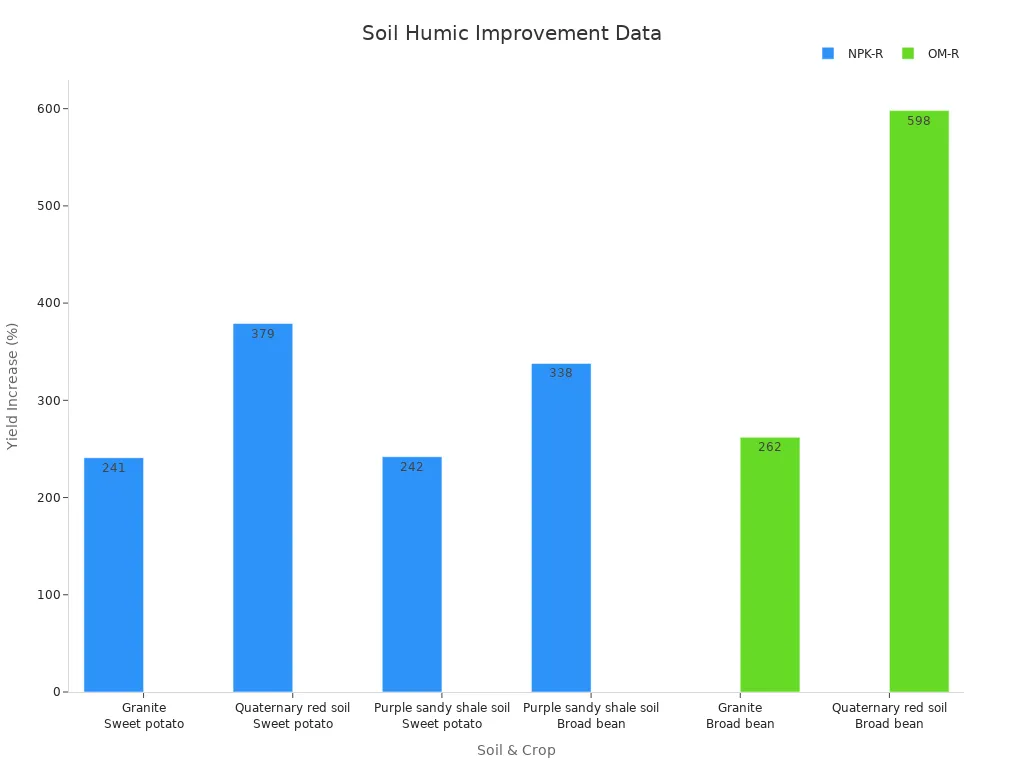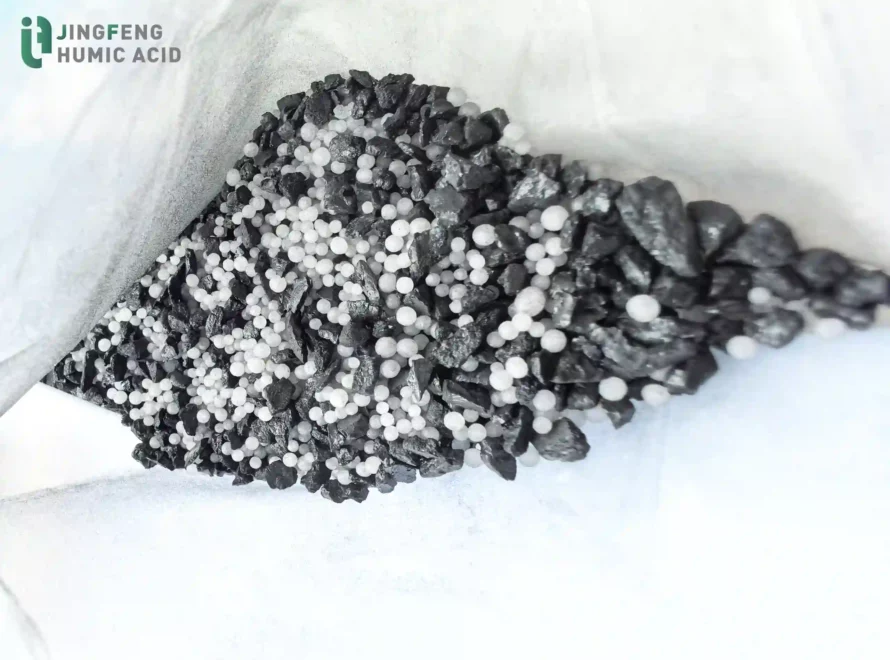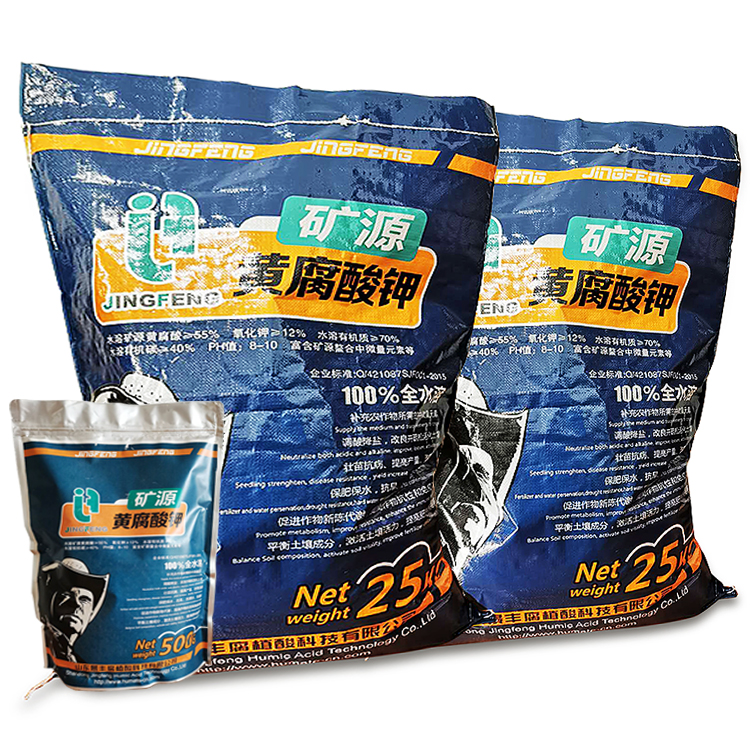
Humic soil refers to soil rich in humic substances, which play a major role in supporting plant growth. Scientists have found that humic acids in soil contain important groups that help microbes break down nutrients and support nitrogen cycling. These humic compounds allow bacteria to turn nitrate into forms plants can use, which increases soil fertility. Farmers notice that crops grow better in humic soil because it holds more nutrients and water. Understanding what makes humic soil unique helps growers make better choices for healthy crops.
Key Takeaways
- Humic soil contains rich organic matter that holds nutrients and water, helping plants grow stronger and healthier.
- Humic substances like humic acid improve soil structure, boost nutrient uptake, and support beneficial microbes that protect crops.
- Using compost and humic acid can increase soil fertility, reduce the need for chemical fertilizers, and raise crop yields significantly.
- Humic soil helps plants survive drought by holding more water and improving root growth for better nutrient absorption.
- Farmers should monitor soil health regularly and test organic amendments in small areas to build humic content effectively and sustainably.
Humic Soil Basics
What Is Humic Soil
Humic soil contains high levels of humus, which forms from the breakdown of plant and animal remains. This process creates humic substances, including humic acids, fulvic acids, and humin. Farmers and scientists value humic soil because it supports healthy crops. The dark color of humus-rich topsoil shows the presence of organic matter and compost. Humic soil stands out for its ability to hold nutrients and water, making it ideal for growing plants. People often add compost or organic material to increase the humus content in their fields.
Key Properties
Researchers have measured several important properties of humic soil. These include the amount of carbon, hydrogen, nitrogen, and oxygen in the humus. The table below shows typical ranges for these elements:
| Property | Range / Description |
|---|---|
| Carbon (C) | 33.38% – 39.55% |
| Hydrogen (H) | 35.57% – 43.81% |
| Nitrogen (N) | 2.55% – 4.21% |
| Oxygen (O) | 18.10% – 22.80% |
| H/C Ratio | 0.91 – 1.31 (shows maturity of humus) |
Humic soil also contains active enzymes, such as urease and phosphatase, which help break down organic matter and release nutrients. These enzymes keep working even when the total amount of organic matter drops, showing the resilience of humic substances.
Humic Soil vs. Other Soils
Humic soil differs from other soils in both composition and fertility. Scientists use advanced tools like mass spectrometry and NMR to study the molecular structure of humic acids. These studies reveal that humic soil has more aromatic compounds, fatty acids, and special markers from plants and microbes. Compared to other soils, humic soil holds more soil organic matter and resists breakdown better.
- Comparative studies show:
- Humic soil has higher levels of organic carbon and compost.
- It supports better seed germination and crop growth.
- The structure of humus in humic soil changes less after events like fires.
- Fertilizer effects vary depending on the amount of humus and organic matter present.
Humic soil provides a strong foundation for healthy crops by storing nutrients and supporting soil life.
Humic Soil Composition
Humic Substances
Humic substances make up the largest part of soil organic matter. Scientists find that these substances account for about 60-70% of all organic material in soil. Humic substances include humic acid, fulvic acids, and humin. Each type has a different role in soil. Advanced tests show that humic substances come mostly from plant material, such as lignin and polysaccharides. These substances have special structures with aromatic rings and oxygen groups. The degree of humification changes the balance between aromatic and aliphatic parts. Brown coal has more aromatic humic substances, while peat has more aliphatic ones. Farmers use humic substances in fertilizers and soil enhancers because they help soil hold water, improve nutrient uptake, and support healthy roots.
- Humic substances:
- Improve soil structure and porosity
- Increase nutrient uptake, especially nitrogen and phosphorus
- Support soil microbes and plant growth
- Bind toxic substances and help plants resist stress
Humic Acid and Humic Acids
Humic acid and humic acids are key parts of humic substances. They form when organic matter breaks down over time. High humic acid levels in soil lead to better plant growth and higher yields. Humic acid helps soil hold nutrients and water. It also boosts enzyme activity and supports beneficial microbes. Laboratory studies show that humic acid increases soil pH, organic matter, and exchangeable calcium. In field trials, humic acid improved crop yield and fruit quality. Humic acids also help plants use fertilizers more efficiently. Products with high humic acid levels can reduce the need for mineral fertilizers by up to 50% and increase nutrient availability by up to 70%. Leonardite, a soft brown coal, is a natural source of humic acids. Many soil products use leonardite to raise humic acid levels.
Humus in Soil
Humus is the dark, stable part of soil organic matter. It forms after organic material fully decomposes. High humus levels mean the soil can store more nutrients and water. The humus layer acts as a buffer, protecting soil from erosion and temperature changes. In forests, humus thickness can range from 1.1 to 26.7 cm, depending on climate and elevation. Humus supports soil structure, nutrient cycling, and microbial activity. Studies show that humus helps soil retain carbon and improves the balance of nitrogen, phosphorus, and carbon. Soil with more humus has better enzyme activity and more stable organic carbon. Humus, along with humic acid, fulvic acids, and humin, forms the backbone of healthy soil.
Humic Soil Benefits

Nutrient Retention
Humic soil plays a vital role in holding nutrients for plants. The presence of humus and humic acid increases the soil’s ability to keep plant nutrients available for longer periods. Humic acids act like sponges, trapping nutrients such as nitrogen, phosphorus, and potassium. This process prevents nutrients from washing away during rain or irrigation. As a result, plants can access these nutrients when they need them most.
A two-year field experiment in calcareous soils showed that bio-organic fertilizers with humic substances and vermicompost greatly improved nutrient retention. For example, zinc and manganese levels stayed high in soils treated with these amendments, while control soils lost nutrients over time. The table below shows how nutrient content changed with different treatments:
| Nutrient | Control Soil Content (mg/kg) | Mineral Fertilizer Content (mg/kg) | ALCRI-Vermicompost Content (mg/kg) | Effect |
|---|---|---|---|---|
| Zinc (Zn) | 1.32 (2023) to 1.76 (2024) | 0.87 (2023) to 0.65 (2024) | 9.05 (2023) to 8.56 (2024) | Vermicompost greatly increased Zn availability. |
| Manganese (Mn) | 3.01 (2023) to 4.00 (2024) | 1.71 (2023) to 2.32 (2024) | 20.64 (2023) to 22.30 (2024) | Highest Mn content with vermicompost. |
| Iron (Fe) | Lower baseline levels | Lower than bio-organic treatments | Increased Fe2+ content sustained | Bio-organic fertilizers improved Fe availability. |
Humic acid and fulvic acid also help plants absorb water and nutrients, even under stress from salty soils. These compounds support root growth and keep the balance of ions in the plant, which helps maintain soil fertility. Farmers who use humic soil amendments often see better nutrient retention and healthier crops.
Soil Structure and Water Holding
Humic soil improves the physical structure of the soil. Humus and humic acids bind soil particles together, creating stable aggregates. These aggregates allow air and water to move freely, which helps roots grow deeper and stronger. Scientific research shows that humic substances increase the soil’s water holding capacity. Soils with more humus can store more water, making it available to plants during dry periods.
Studies using advanced methods, such as fluorescence spectroscopy, confirm that humic acid changes the way soil holds water. The polymeric nature of humic substances helps soil resist compaction and erosion. Farmers notice that fields with high humic acid levels stay moist longer and support better germination. Improved soil structure also means less runoff and better use of rainfall or irrigation.
Tip: Adding organic matter, such as compost or manure, can boost humus and humic acid content, leading to better soil structure and water retention.
Microbial Activity
Humic soil supports a rich community of beneficial microbes. Humic acid acts as a food source for bacteria and fungi that help break down organic material. Field studies on crops like Panax notoginseng and peanuts show that applying humic acid increases the number of helpful bacteria, such as Bradyrhizobium, and reduces harmful ones. This shift in microbial balance leads to healthier soil and stronger plants.
Humic acids also improve the stability of microbial networks. These networks help cycle plant nutrients and protect crops from disease. After humic acid treatment, soils show higher levels of total nitrogen, phosphorus, potassium, and organic matter. Enzyme activity rises, which means microbes work faster to release nutrients for plant growth. Farmers often see better germination and higher crop yield when they use humic soil amendments.
- Key benefits of humic acid for soil microbes:
- Increases beneficial bacteria and fungi
- Boosts enzyme activity for nutrient cycling
- Reduces harmful microbes
- Supports disease resistance in crops
Extensive field trials in Iowa from 2010 to 2013 found that humic products consistently increased maize yield and leaf area. On-farm surveys confirmed grain weight increases of 6.5% over three seasons. These results show that humic soil not only improves soil fertility but also leads to higher yields and better crop health.
Improving Humic Soil
Building Humic Content
Farmers can build humic content by adding compost to their fields. Compost comes from plant and animal materials that break down over time. When farmers use compost, they increase the amount of humic substances in the soil. Humic acid, a key part of these substances, helps plants grow by improving hormone pathways and nutrient use. Many studies show that humic acid boosts crop yields and helps crops handle stress. Farmers often combine compost with other amendments, such as biochar, to get better results.
| Treatment | Effects on Soil and Plants |
|---|---|
| Biochar + Humic Acid | Reduced harmful Fusarium, improved soil microbes, higher enzyme activity, better plant growth, stronger roots |
Long-term programs that use compost and humic acid have led to big increases in crop yields and soil health. The table below shows how different treatments affect yield and humic content:
| Treatment | Soil Type | Crop | Yield Increase (%) | Notes on Humic Content and SOC |
|---|---|---|---|---|
| NPK-R | Granite | Sweet potato | 241 | More humic acid carbon and SOC |
| OM-R | Quaternary red soil | Broad bean | 598 | Higher humic acid carbon and SOC stocks |

A sustainable agricultural program that uses compost and humic acid supports healthy soil and strong crops.
Overcoming Challenges
Farmers face challenges when trying to improve humic soil. Microbial communities in the soil can react in different ways to compost and humic substances. Some studies found that fulvic acids, which are low-weight humic substances, help soil microbes and root growth. Other research shows that not all organic acids work the same way. For example, lactic and citric acids boost enzyme activity, but oxalic acid does not. Microbial diversity can also change, making it hard to predict results.
| Study (Year) | Challenge Identified | Methods Used | Key Findings and How Challenges Were Overcome |
|---|---|---|---|
| Yousfi et al. (2021) | Hard to see how fulvic acids affect microbes and roots | Microbial and root growth tests | Fulvic acids help microbes and root length |
| Macias-Benitez et al. (2020) | Microbes react differently to organic acids | Enzyme and DNA tests | Lactic and citric acids help, but oxalic acid does not; diversity changes |
| Wadduwage et al. (2023) | Hard to track biostimulant effects on soil and microbes | Field trials and soil tests | Biostimulants help, but effects change with field conditions |
Farmers can overcome these challenges by testing compost and humic products in small plots before using them widely. They can also use crop management practices that match their soil type and local climate.
Monitoring Soil Health
Farmers need to track changes in humic soil to see if their efforts work. They use tools like soil electrical conductivity (EC) sensors to measure soil EC, water content, and temperature. EC values show how much organic matter and humic substances are in the soil. Farmers often check these values under the same water conditions for accuracy.
- Soil EC sensors give real-time data on humic content.
- EC values link to soil organic matter, nutrients, and humic substances.
- Farmers use correlation analysis and principal component analysis (PCA) to study soil samples.
- They measure each sample three times for reliable results.
- Calibration for soil moisture helps keep readings accurate.
Tip: Regular monitoring helps farmers adjust compost use and improve soil health for better crop yields.
Humic soil plays a vital role in crop production. Farmers see higher yield and healthier plants when they focus on building humic content.
- Humic substances improve soil structure, water retention, and nutrient availability.
- They help roots grow deeper and protect crops from stress and disease.
- Studies show humic acid can boost wheat yield by up to 46.9% and reduce the need for chemical fertilizers.
Ongoing soil management and learning help growers achieve better results. Farmers should make humic soil health a top priority for sustainable farming.
FAQ
What is the main difference between humic acid and fulvic acid?
Humic acid has a larger molecule and stays in the soil longer. Fulvic acid has a smaller molecule and moves easily in water. Both help plants, but they work in different ways.
How can farmers increase humic content in their soil?
Farmers can add compost, manure, or plant residues. These materials break down and form humic substances. Regular use of organic matter helps build healthy humic soil.
Does humic soil reduce the need for chemical fertilizers?
Yes. Humic soil holds nutrients better and makes them available to plants. Farmers often use less chemical fertilizer when they improve humic content.
Can humic soil help plants during drought?
Humic soil holds more water. Plants in humic soil can survive dry periods better. Farmers see stronger crops when soil has more humus.
Is humic soil safe for all crops?
Yes. Humic soil supports most crops. It improves soil health and plant growth. Farmers use it for vegetables, grains, and fruit trees.





